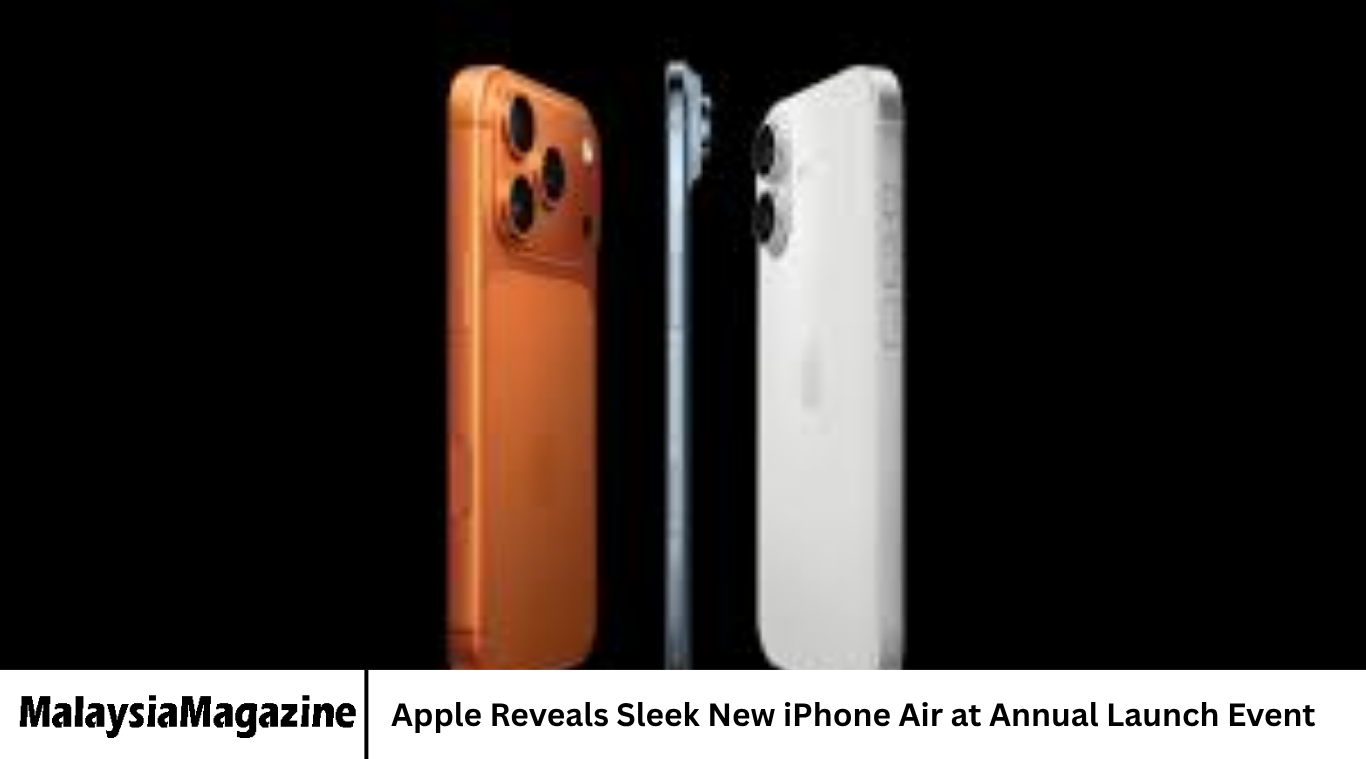Apple has unveiled the all-new iPhone Air at its annual product launch event, introducing one of the slimmest and lightest smartphones ever created by the company. The iPhone Air represents a major design shift for Apple, combining powerful performance with an ultra-thin body and modern features that redefine the balance between elegance and technology.
The launch event, held at Apple Park in Cupertino, California, featured several new products, but the iPhone Air stood out as the headline announcement. Designed for users who value sleekness without sacrificing performance, the new model showcases Apple’s commitment to pushing the boundaries of innovation in mobile technology.
The Concept Behind the iPhone Air
Apple’s decision to introduce the iPhone Air is inspired by the same philosophy that led to the creation of the MacBook Air—lightweight, minimal, and efficient. The company has been moving toward thinner, more sustainable designs for years, and the iPhone Air is a continuation of that trend.
The name “Air” suggests lightness and mobility, two qualities Apple believes modern users prioritize. By focusing on a slimmer profile and improved comfort, the company aims to appeal to users who prefer a device that feels refined, stylish, and easy to handle.
Despite its thin frame, the iPhone Air is not a compromise in performance. Apple engineers have redesigned the internal architecture to accommodate a powerful chip, a larger battery, and advanced cameras, all within a smaller space. This combination of aesthetics and power is central to the iPhone Air’s identity.
Design and Build
The iPhone Air is Apple’s thinnest iPhone ever, measuring just 6.1 millimeters in thickness and weighing noticeably less than the previous generation models. The phone’s aluminum body and ceramic shield front give it a sleek yet durable structure. Apple introduced new color options, including Sky Blue, Silver Mist, Rose Titanium, and Graphite Gray, giving the device a modern and elegant appeal.
The edges are slightly curved for better grip, while the back features a matte finish that resists fingerprints. The redesigned camera module sits flush with the body, creating a smoother look compared to the raised lenses of older models. This design choice contributes to the phone’s minimal aesthetic, which Apple describes as “a perfect balance of form and function.”
Another notable feature is its improved cooling system, allowing the device to maintain top performance without overheating despite the slimmer design.
Display and Visual Experience
Apple equipped the iPhone Air with a 6.1-inch Super Retina XDR OLED display, offering sharper visuals, brighter colors, and improved contrast. The display supports ProMotion technology, allowing a refresh rate of up to 120Hz for smoother scrolling, gaming, and video playback.
The company claims the new screen consumes 15 percent less power than previous models while delivering even better brightness and clarity. True Tone and HDR10 support ensure that visuals look natural and detailed in all lighting conditions.
For users who enjoy multimedia experiences, the iPhone Air offers enhanced color calibration and Dolby Vision support, providing cinema-level visual quality right in the palm of your hand.
Power and Performance
At the heart of the iPhone Air is Apple’s latest A18 Bionic chip, built with advanced 3-nanometer technology. The chip features improved CPU and GPU cores, enabling faster performance and better energy efficiency. This means smoother multitasking, faster app launches, and an overall more responsive user experience.
The Neural Engine, which powers AI and machine learning tasks, has also been upgraded. This allows the iPhone Air to handle real-time image processing, voice recognition, and augmented reality applications with greater accuracy and speed.
Apple emphasized that the A18 chip also contributes to better battery life, even though the device is thinner. Through optimization, the iPhone Air delivers up to 18 hours of video playback on a single charge, thanks to more efficient power management and adaptive processing.
Camera Innovations
The iPhone Air features a dual-camera system designed to deliver professional-grade photography in a compact design. The main wide sensor has a 48-megapixel resolution, while the ultra-wide lens captures expansive shots with impressive detail. Both lenses benefit from Apple’s advanced computational photography, powered by the A18 Bionic chip.
The new camera system supports Smart HDR 6, Night Mode improvements, and real-time depth control, allowing users to take clear and vivid photos in any lighting condition. Apple also enhanced image stabilization to reduce motion blur in both photos and videos.
On the video side, the iPhone Air offers 4K recording at up to 60 frames per second, cinematic mode for dynamic focus control, and ProRes support for professional videographers. The front camera has been upgraded with a 12-megapixel sensor and improved low-light performance, making it ideal for selfies and video calls.
Battery and Charging Enhancements
One of the key challenges in creating a slim smartphone is maintaining good battery performance. Apple addressed this with a newly designed battery structure that fits tightly into the compact frame. The iPhone Air delivers impressive endurance, offering full-day battery life for normal use.
The device supports both MagSafe and wired fast charging. Users can get up to 50 percent charge in around 25 minutes with a compatible fast charger. Apple also introduced a new eco-friendly charging feature that learns users’ charging habits to extend battery health over time.
Wireless charging has also been optimized, with better heat control and faster charging speeds compared to previous models.
Software and Features
The iPhone Air comes preloaded with iOS 19, Apple’s latest operating system. The new software introduces a range of AI-driven features designed to make everyday tasks faster and more intuitive.
Siri has been redesigned with more natural responses and offline capabilities, while Apple Intelligence—a suite of on-device AI tools—helps users organize photos, summarize texts, and even write emails automatically.
Other software improvements include better privacy controls, redesigned widgets, and customizable lock screens. iOS 19 also integrates more deeply with Apple’s ecosystem, offering seamless connectivity with Apple Watch, Mac, and iPad devices.
Sustainability and Materials
Apple continues its focus on environmental responsibility with the iPhone Air. The device is built using 100 percent recycled aluminum for the frame and 100 percent recycled rare earth elements in its magnets. Packaging is completely plastic-free, part of Apple’s ongoing goal to eliminate all plastic from its products by 2030.
The company also designed the iPhone Air with repairability in mind. The internal structure allows easier battery and screen replacements, extending the device’s usable lifespan and reducing electronic waste.
Market Position and Pricing
The iPhone Air is positioned between the standard iPhone 16 and the iPhone 16 Pro models. It targets users who value design and portability but still want flagship-level performance. By introducing this model, Apple aims to reach a broader audience, including those who prioritize elegance and simplicity over extreme hardware power.
The base model starts at $799 for the 128GB version, with higher storage options available. Apple expects the iPhone Air to become one of its most popular models, especially among professionals, students, and frequent travelers who prefer a lightweight yet capable smartphone.
Preorders begin next week, with availability scheduled for the following month in major global markets.
Consumer and Industry Reactions
Initial reactions to the iPhone Air have been overwhelmingly positive. Industry experts praised Apple for achieving a balance between sleek design and strong performance. Reviewers highlighted the thinness, improved battery life, and refined aesthetics as standout features.
Consumers have also shown excitement for the new design direction. Many see the iPhone Air as a return to Apple’s minimalist roots, reminiscent of the early days of the iPhone lineup when elegance and simplicity were at the heart of its appeal.
Some analysts suggest that the iPhone Air could influence competitors to rethink their design strategies, potentially leading to a new trend of ultra-slim smartphones in the market.
Challenges Ahead for Apple
While the iPhone Air launch has generated enthusiasm, Apple still faces challenges. Competition in the smartphone industry remains fierce, especially from Samsung, Google, and Chinese manufacturers that are introducing foldable and AI-integrated devices.
Another challenge lies in pricing. Although the iPhone Air offers strong value for its features, it still falls within the premium price range, which could limit its reach in some markets.
Supply chain pressures and production costs may also influence availability during the initial months of release. However, Apple’s well-established logistics and manufacturing partnerships are expected to manage these challenges effectively.
Future Prospects and Apple’s Strategy
The iPhone Air launch signals Apple’s intention to diversify its product lineup while maintaining the high standards that define its brand. By focusing on design innovation and sustainability, Apple is shaping a new generation of devices that combine environmental responsibility with technological advancement.
This strategy aligns with the company’s long-term goals of reducing environmental impact, strengthening brand loyalty, and continuing to lead the premium smartphone market. The success of the iPhone Air could also influence future product designs across Apple’s ecosystem, including iPads and MacBooks.
Frequently Asked Questions
What makes the iPhone Air different from other iPhones?
The iPhone Air is Apple’s thinnest and lightest model ever, offering top performance in a slim, elegant design with the new A18 Bionic chip and advanced camera system.
What is the display size of the iPhone Air?
The iPhone Air features a 6.1-inch Super Retina XDR OLED display with ProMotion technology and HDR10 support for superior visual quality.
How long does the battery last on the iPhone Air?
The iPhone Air provides up to 18 hours of video playback and includes fast and wireless charging options for quick and convenient power.
Which chip powers the iPhone Air?
The iPhone Air runs on Apple’s A18 Bionic chip, offering faster processing, improved AI performance, and greater energy efficiency.
Is the iPhone Air environmentally friendly?
Yes, Apple built the iPhone Air using 100 percent recycled aluminum and rare earth materials, along with plastic-free packaging.
When will the iPhone Air be available for purchase?
Preorders begin next week, and the phone will officially launch in stores and online next month in major global markets.
Conclusion
The unveiling of the iPhone Air marks a major milestone for Apple, both in design and innovation. With its ultra-slim body, advanced A18 chip, enhanced cameras, and improved battery performance, the iPhone Air redefines what a modern smartphone can be.
It reflects Apple’s vision of creating technology that is both powerful and elegantly simple. Beyond its aesthetics, the iPhone Air represents a commitment to sustainability, performance, and user experience.
As consumers embrace the new model, the iPhone Air is expected to become one of Apple’s most successful releases in recent years, setting a new standard for how smartphones blend style, intelligence, and practicality.
















